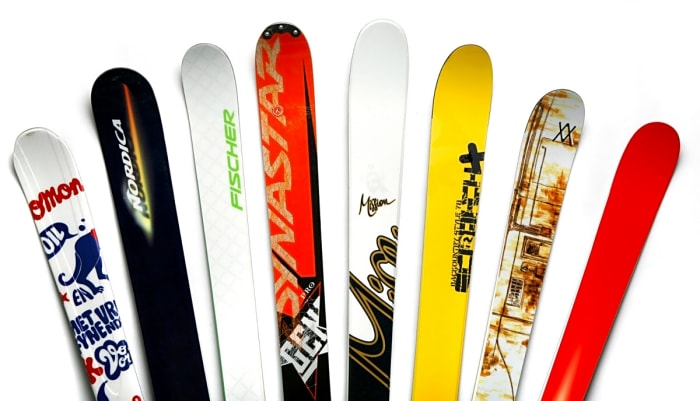Powder skiing is best described in superlatives. Words like deepest, lightest, fluffiest, or perhaps just the simplest descriptor best get thrown around like dice at a craps table. It's a testament to the otherworldly feeling provided by weightless and effortless powder turns, none of which would be possible without the right types of skis on our feet. Those skis, on the other hand, are best described by a single word that the ski industry has latched onto and absolutely run with: fat.
But have powder skis changed much over the years? Abso-freakin'-lutely. I'd even go so far as to say that they've changed more than any other type of ski. Of course, up until the advent of purpose-built powder skis, skiers tended to simply use longer lengths of "regular" skis for extra flotation in deeper snow. It wasn't until the early '90s that wider waist widths really caught on, with the introduction of the first commercially available fat ski, Atomic's Powder Plus (later called the Powder Magic), and the line of skis it spurred.
The First "Fat Ski"
Skiers had long sought out untracked snow in the backcountry, but it wasn't until ski gear, safety equipment, and knowledge about snow science and avalanches caught up that powder skiing became truly popular. By the early '90s, the explosion of heli skiing in Alaska and the high mountains of Alberta and British Columbia, plus relaxed resort boundary policies in North America led to more and more skiers venturing into deep snow.
Atomic responded to this newly growing market segment by releasing the Powder Magic in 1988. It was a 115mm underfoot ski that was both significantly fatter and substantially shorter than other skis of the era. Prototypes were built by sawing a snowboard in half. This new shape not only allowed for greatly increased flotation, allowing skiers to stay on top of deep snow, but the shorter length and tapered tips and tails made it much easier to initiate turns in the three-dimensional medium that is powder snow.
The Advent of Twin Tips

Powder ski design got its next big glow-up with the advent of twin-tip skis. First marketed by the French ski maker Salomon, with heavy input from Canadian ski superstar Mike Douglas, twin tips weren't expressly designed for soft-snow skiing. In fact, the first twin tip released in 2001, Salomon's revolutionary TenEighty, was really meant for one thing only: allowing Mike Douglas and other freeskiers to land backwards off big jumps.
Of course, the prospect of landing in deep snow (much softer, to cushion hard impacts) led to these skis being used heavily in the backcountry. The 1080 turned into the Pocket Rocket, a wider version that was more appropriate for deep snow, but still only sported a 90mm waist. The turned-up tail made for a looser-feeling ski that many leading skiers
Shane McConkey Enters the Fray
Modern powder ski design wouldn't exist without one of the main characters of skiing: the late Shane McConkey. Ever the experimenter, McConkey was always willing to try new things, like skiing in Alaska on water skis, to see how he could further progress the sport.
That water ski experiment led to a radical rethinking of ski design and the introduction of reverse camber and reverse sidecut in 2001. McConkey's sponsor, Volant Skis, marketed the aptly-named Spatula, an absolutely monstrous ski that was designed to ski 100 percent in powder. While most skis of the era leaned into aggressive sidecut (where the waist was narrower than the tip and tail), the Spatula flipped the script, with a 125mm waist and a pintail-like design.
The Spatula's design required an entirely new technique to ski, encouraging high speeds and "slarved" turns without edge engagement. McConkey famously wrote instructions that were included in the box of each pair sold.
Rocker and Wide Waists Go Mainstream
Taking lessons learned from the Spatula, Pocket Rocket, and other cutting-edge skis of the time, manufacturers settled into a groove by the mid-2000s. New marketing terms like "rocker" and "early rise" were thrown around at industry trade shows and on ski retailer floors.
These terms essentially meant a combination of both reverse camber and camber in a ski, where the ski retained a short section of camber underfoot, for better edge control and some pop, combined with reverse camber in the tip and tail. This led to skis having more pronounced tip splay to allow them to plane up and over powder snow, while still retaining some ability to ski predictably in firm conditions.
Beyond shape, manufacturers began experimenting with different materials like carbon fiber, foam, and various types of metals inside skis to tune flex and other characteristics. Some popular skis from this era were the K2 Pontoon (also designed by McConkey) and AK Enemy, Rossignol's Super series, Rossignol's Bandit series, and Atomic's Big Daddy.
The Fat and Floppy Era
Once brands figured out construction materials and saw the commercial popularity of skis that were easy to ski in deep snow, things got a little crazy. Starting in the late 2000s, we entered what I like to call the "Fat and Floppy" Era, when manufacturers went apeshit with waist widths, pushing them into high 120, even into the 130+ millimeter underfoot range. That was combined with really floppy and hilariously splayed tips and tails with massive amounts of rocker, paired with a largely symbolic amount of rocker underfoot, to "get you back to the lift." Oh yeah, and cartoonishly grotesque topsheets.
This was the era of skis like K2's Hellbent and ObSethed, Völkl's Kuro and Sumo, Rossignols, the Fat-ypus A-Lotta, Line's Prophet 130, Armada ARG and Bubba, and the DPS Lotus 138, to name a few.
This was also the era of iconic video parts filmed in wildly deep snow all over the world. Think Eric Pollard's Nimbus Independent flicks, MSP's Superheroes of Stoke, Rage Films' Such Is Life, and more.
Reverse Camber Rules (For a While)
In keeping with the trend of extreme design progression, things got even crazier for a few years around the early 2010s, when brands took the whole reverse camber craze perhaps a little too far. For a few years there, we saw reverse camber construction on everything from powder skis, to park skis, to carving skis, of all things. New tech is always a marketer's dream, and ski consumers ate it right up.
Despite the craziness, two brands in particular nailed it with the reverse-camber construction on powder skis: 4FRNT with the EHP (and eventually the Renegade, Hoji, and Raven skis), and Völkl with the Katana and BMT series. Instead of the exaggerated banana rocker found in the previous generation of reverse-camber skis, these approached the matter with a degree of subtlety, with super long and low rocker lines paired with long sidecuts (25+ meters!) to allow for really surfy turns in deep snow. These are still some of my favorite powder skis to date.
The Resurgence of Freeride & Today's Powder Skis
Much like the late '90s, the mid-2010s saw a resurgence in big-mountain freeride skiing. In fact, it never really went away during the in-between years, but the industry at large was more heavily focused on freestyle skiing, racing, and "frontside" skiing in the resort. There's another glossy marketing term for you.
Luckily, thanks to ski media, personal interest from athletes, and the re-emergence of big-mountain competitions, big-mountain freeride skiing enjoyed a renaissance sometime in the mid-2010s. Those fat and floppy reverse camber skis didn't really cut it on the gnarliest, technical terrain, so powder ski construction evolved yet again. This time, however, it headed in the opposite direction and landed us somewhere near where we're at today, with narrower waist widths and even more refined construction.
Without a doubt, 120-plus millimeter-underfoot skis are wildly fun to ski, but there's no denying that there are more versatile shapes for hard-charging technical riding. These days, unless you're skiing in Japan, Alaska, Washington, or the Tetons (or just don't give a damn about your knees at the resort), something in 105 to 115-underfoot range is much more usable.
Versatility has become the latest buzzword, and it's one that I can definitely get behind. That slightly narrower waist width tends to be paired with carefully-designed tip and tail rocker to give the ski all the float and surfiness you could ever want, while providing solid edge hold and the ability to plow through the reality of what we mostly ski inbounds: crud and variable snow.
More must-reads:
- Jalen Johnson joins pair of legends by making history in Hawks' win
- Penguins have to consider drastic changes after blowing yet another huge lead
- The '2025-26 bowl game host cities' quiz
Breaking News
Trending News
Customize Your Newsletter
 +
+
Get the latest news and rumors, customized to your favorite sports and teams. Emailed daily. Always free!








